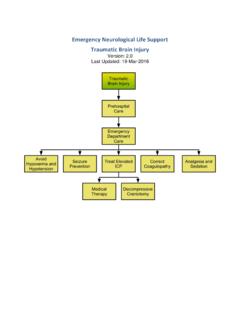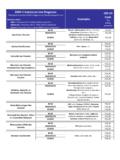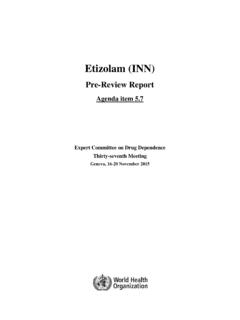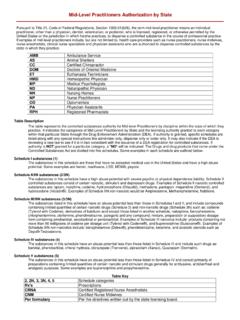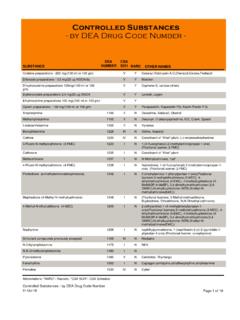Transcription of Emergency Neurological Life Support Status …
1 Emergency Neurological life Support Status Epilepticus Protocol Version: Last Updated: 19-Mar-2016 Checklist & Communication Status Epilepticus Table of Contents Emergency Neurological life Support .. 1 Status Epilepticus Protocol .. 1 Checklist .. 3 Communication .. 3 Diagnosis .. 4 The diagnosis of Status epilepticus .. 4 Emergent Initial Treatment of Status Epilepticus .. 5 Treatments administered before hospital admission .. 5 Seizures Have Stopped .. 6 And the patient is following commands .. 6 Status Epilepticus.
2 7 Unremitting seizures .. 7 Status Epilepticus Terminated? .. 8 Have the seizures stopped or the patient began following commands? .. 8 Seizures have not stopped .. 8 Or they stopped but the patient will not awaken .. 8 Treatment of Refractory Status Epilepticus ..10 If Status epilepticus has still not halted ..10 Urgent Control Therapy ..12 If not already done pre-hospital ..12 Status Epilepticus Page 3 Checklist Fingerstick glucose Obtain IV access Monitor pulse oximetry, BP, cardiac; supplemental O2, fluid as needed, cardiac monitor Order labs.
3 Complete Blood Count, Basic Metabolic Profile, Calcium, Magnesium, anticonvulsant drug levels Head CT (appropriate for most cases) Continuous EEG monitoring - Notify EEG tech (as soon as available unless patient returns to pre- Status epilepticus baseline) Communication Clinical presentation Duration of Status epilepticus Relevant Past Medical History and Past Surgical History Prior medications, medication given so far, anticonvulsant drug levels if drawn Neurological examination Brain imaging/LP results (if available) Status Epilepticus Page 4 Diagnosis The diagnosis of Status epilepticus The clinical definition of Status epilepticus is five minutes or more of convulsions or 2 or more convulsions in a 5-minute interval without return to preconvulsive Neurological baseline.
4 However, a patient may be seen to seize, then, when brought into the hospital may not regain consciousness quickly. This too may be Status epilepticus and usually requires EEG monitoring to diagnose. Traditional definition of Status epilepticus required 30 minutes of intermittent on continuous seizure activity. Do not wait for 30 minutes to pass before starting antiepileptic medications since permanent brain injury may occur before 30 minutes have elapsed and most seizures that do not progress to Status will be shorter than 5 minutes. Status Epilepticus Page 5 Emergent Initial Treatment of Status Epilepticus Treatments administered before hospital admission Seizures are most frequently diagnosed outside of the hospital and EMTs and paramedics are the often the first responders to the patient.
5 Do the following: ABCs, including supportive care if needed (O2, airway, blood pressure) Obtain IV access if possible Diagnose hypoglycemia: if hypoglycemic give D50W 50 ml IV and thiamine 100 mg IV (may be given empirically if suspected in the absence of a definitive diagnosis) For adult patient give lorazepam 4 mg over 2 min IV or diazepam 5 mg IV or midazolam 10 mg IM Adult alternatives include: diazepam 20 mg PR (may use diastat or IV solution of diazepam) In children with IV access, give: Lorazepam mg/kg IV, maximum dose 4 mg For children 13-40 kg, an alternative is midazolam 5 mg given IM For children 40 kg or larger, an alternative is midazolam 10 mg IM Comments: Time is control.
6 The most important factor in predicting ease of seizure control is the time elapsed prior to initiating anticonvulsants. If the medical professional is unable to get intravenous access for IV benzodiazepine, give benzodiazepines via an alternate route. IM administration of midazolam 10 mg has been proven to be effective. Respiratory decompensation is more commonly encountered in untreated Status epilepticus than in Status epilepticus treated with benzodiazepines. Weight based benzodiazepine administration may be appropriate in certain circumstances but is an off-label use, more prone to dose calculation error, and there are no data showing that it is superior Lorazepam needs to be refrigerated or restocked every 60 days.
7 For this reason, it is usually impractical for EMS use and diazepam or midazolam are used as alternatives. Status Epilepticus Page 6 Seizures Have Stopped And the patient is following commands The half- life of benzodiazepines is brief and therefore a longer-lasting anticonvulsant needs to be administered to prevent recurrent seizures. For Adult patients, give: Fosphenytoin: load 20 mg/kg IV at up to 150 mg/min - OR Phenytoin 20 mg/kg IV at up to 50 mg/min - OR - Valproic acid: load: 40 mg/kg IV over 10 min For children, give: Fosphenytoin: load 20 mg/kg IV at up to 150 mg/min If possible connect to EEG unless the patient wakes up or returns to pre-convulsive baseline.
8 Determine the cause of the seizure (prior history of seizures and medication non-compliance, new onset seizure, etc.) Serum levels of anticonvulsants are useful to determine what threshold the patient with epilepsy has for developing seizures. Urine toxicology screen may be helpful for recreational drug-associated seizures. In children CNS infections or underlying genetic or metabolic disorders are more frequently the cause of Status epilepticus. Status Epilepticus Page 7 Status Epilepticus Unremitting seizures Status Epilepticus: Ongoing seizure activity is injurious to the brain and can cause other organ system problems like pneumonia and sudden death.
9 Making an accurate diagnosis is essential as is the orderly institution of anticonvulsant drugs to terminate the seizure activity. This protocol gives a practical, step-by-step guide to how Status epilepticus can be terminated. Topic Co-Chairs: Jan Claassen, MD James J. Riviello Jr, MD Robert Silbergleit, MD Status Epilepticus Page 8 Status Epilepticus Terminated? Have the seizures stopped or the patient began following commands? Status epilepticus is terminated when the patient returns to his/her pre- Status responsiveness or there is EEG evidence of seizure cessation.
10 Even if the convulsions have stopped the patient may still be seizing. If the patient does not rapidly awaken following the administration of the first line anticonvulsants, one should consider the patient still may be seizing. Seizures have not stopped, or they stopped but the patient will not awaken Start second line anticonvulsant. For adults, choose one of the following: Fosphenytoin: load 20 mg/kg IV at up to 150 mg/min - OR - Phenytoin 20 mg/kg IV at up to 50 mg/min - OR - Valproic acid: load: 40 mg/kg IV over 10 min (may give additional 20 mg/kg over 5 min if still seizing) For children, give: Fosphenytoin: load 20 mg/kg IV at up to 150 mg/min Arrange EEG monitoring.
